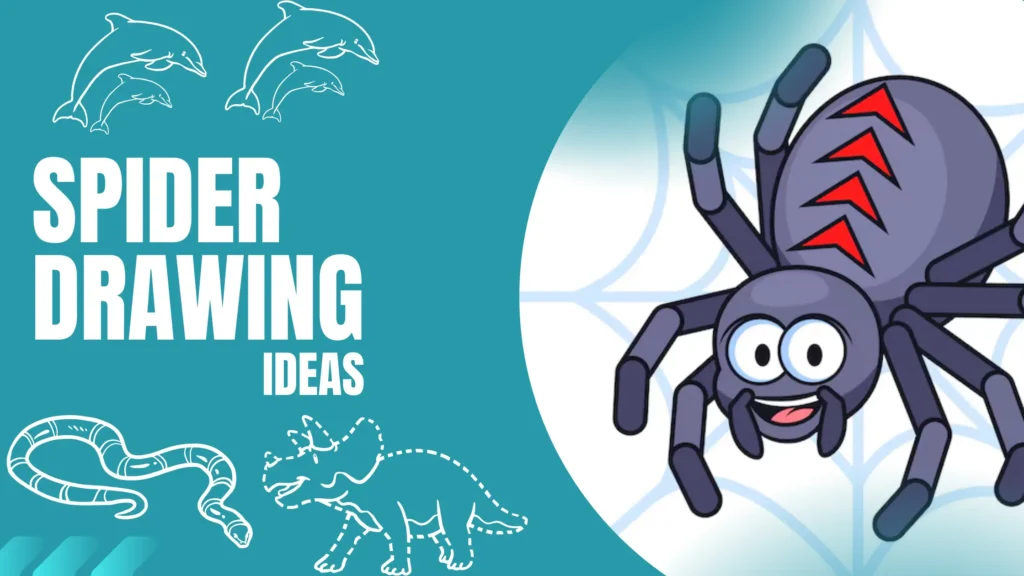Drawing spiders can be enjoyable and surprisingly simple, whether you’re a beginner or an experienced artist exploring new ideas. From cute cartoon spiders to detailed tarantulas, there’s a style for everyone to try.
With just a few easy steps, you can create spider sketches perfect for kids’ activities, art projects, or even seasonal decorations like Halloween. Let your creativity guide you as you bring these eight-legged creatures to life with your own unique touch.
Drawing spiders is not only a fun way to pass the time but also a great opportunity to practice and grow your artistic skills. Grab your pencils and start sketching your very own spider-themed masterpieces!
>> Check Out: Fun & Easy Drawing Ideas
Contents
- 1 Easy Spider Drawing Guide
- 1.1 Cute Cartoon Spider
- 1.2 Spider in a Web
- 1.3 Halloween Spider Art
- 1.4 Adorable Baby Spider
- 1.5 Realistic Spider Made Simple
- 1.6 Spider Silhouette Sketch
- 1.7 Fun Spider Doodles
- 1.8 Beginner Spider Drawing
- 1.9 Friendly Spider Design
- 1.10 Hanging Spider Idea
- 1.11 Close-Up Spider Sketch
- 1.12 Easy Tarantula Drawing
- 1.13 Side-View Spider Art
- 1.14 Minimal Spider Line Art
- 1.15 Short Video On Spider Drawings
- 1.16 Conclusion
- 1.17 Common FAQS:
Easy Spider Drawing Guide

Learn how to draw a simple spider with easy steps. Start by sketching a small circle for the head and a larger oval for the body. Add eight straight or slightly curved legs extending from the body.
You can keep the design basic or add tiny details like eyes and a smile. Perfect for beginners, this method is quick and fun to practice.
Cute Cartoon Spider

Create a fun and adorable cartoon spider with ease. Draw a round body and add oversized eyes for a playful expression. Add short, wavy legs to make it look lively. You can also include a cute accessory like a bow or a hat. This style is great for kids’ crafts or doodling sessions.
>> Find Creative Easy Squirrel Drawing Ideas
Spider in a Web

Drawing a spider in a web is both creative and simple. Start with a small spider in the center, using a round body and thin legs. Surround it with a web by drawing intersecting lines in a circular pattern. Add little details like dew drops to enhance the web. It’s a fun project that looks great on paper.
Halloween Spider Art

Spooky spiders are perfect for Halloween-themed art. Begin with a round body and add jagged legs to make it look creepy. Draw a pair of large, glaring eyes and small fangs for extra detail. Place the spider on a web or hanging from a thread for a festive touch. This drawing is easy and perfect for holiday decorations.
>> Discover Beautiful Hedgehog Drawing Ideas
Adorable Baby Spider

An adorable baby spider is simple to draw and fun to personalize. Start with a round body and tiny, stubby legs. Add big, sparkling eyes and a small smile to make it cute. You can also draw it holding a tiny object like a flower. This charming design is ideal for children’s art projects.
Realistic Spider Made Simple

Drawing a realistic spider doesn’t have to be overwhelming. Start with an oval body and carefully add long, thin legs. Include small details like texture on the body and lines on the legs. Focus on keeping the proportions accurate but don’t worry about perfection. This method helps you achieve realism while keeping it manageable.
Spider Silhouette Sketch

Spider silhouettes are striking and easy to draw. Use a dark oval shape for the body and straight lines for the legs. Focus on keeping the overall outline clean and sharp. Silhouettes are perfect for Halloween, logos, or minimalist art. They are quick to create and have a bold, impactful look.
>> Playful Panda Drawing Ideas for Beginners
Fun Spider Doodles

Spider doodles are a great way to get creative. Draw small, simple spiders with fun expressions. Use curved or zigzag lines for legs and add quirky details like hats or glasses. These quick doodles are perfect for decorating notebooks or cards. Let your imagination flow and enjoy the process.
Beginner Spider Drawing

Start your spider drawing journey with an easy design. Draw two circles for the body and add straight lines for legs. Keep the details minimal, focusing on clean and simple shapes. This beginner-friendly approach helps you practice without feeling overwhelmed. It’s a perfect first step for learning to draw spiders.
>> Find Out Easy Dragonfly Drawing Ideas
Friendly Spider Design

Draw a spider that looks cheerful and inviting. Use soft, curved lines for the body and legs to make it approachable. Add large, happy eyes and a friendly smile. You can also include small accessories like a flower or balloon for extra charm. This drawing style is ideal for children’s stories or crafts.
Hanging Spider Idea

A hanging spider adds a dynamic touch to your drawing. Start with a small spider body and long legs. Draw a thread extending from the top to give the illusion of it hanging. Add motion lines or shadows to make it more lively. This creative idea is simple yet visually appealing.
Close-Up Spider Sketch

A close-up spider drawing is perfect for exploring details. Focus on the spider’s head, eyes, and mandibles. Draw each feature clearly to highlight the anatomy. Include textures like small hairs or patterns on the body for a realistic touch. This style is great for improving your observation skills.
>> Check out: Simple & Easy Fish Drawing Ideas
Easy Tarantula Drawing

Tarantulas are large and impressive, but easy to draw. Use an oval shape for the body and thick legs for its unique look. Add patterns or stripes on the body for detail, and keep the proportions simple. This drawing is a great way to explore the anatomy of larger spiders while keeping it beginner-friendly.
Side-View Spider Art

A side-view spider drawing gives a new perspective. Sketch the spider’s body as an oval and arrange the legs on one side. Add small details like eyes and spinnerets for realism. This angle is simple to draw and helps you practice different views of the same subject. It’s a creative way to level up your skills.
>> Get Charming & Cute Bear Drawing Ideas
Minimal Spider Line Art

Minimalist spider line art is modern and elegant. Use a single continuous line to outline the spider’s body and legs. Avoid extra details to keep it clean and simple. This style works well for quick sketches, tattoos, or graphic designs. It’s an excellent way to experiment with minimalism in art.
Short Video On Spider Drawings
Conclusion
Drawing spiders can be a fun and rewarding activity for artists of all levels. From cute and playful designs to realistic or spooky styles, there’s plenty of room for creativity. These simple ideas make it easy for anyone to sketch and turn their imagination into art.
Whether you’re drawing for fun, a school project, or seasonal decorations, spider drawings bring a unique flair to your work. They’re also a great way to practice your artistic skills and gain confidence in adding fine details.
With so many options, you can create anything from lighthearted doodles to striking pieces of art. Grab your pencil, get inspired, and start exploring these spider drawing ideas for your next creative project!
Common FAQS:
How do spider legs work?
Spiders are unusual in using the body fluid pressure or hydrostatic pressure from their blood (or hemolymph) to move. Spiders use hydrostatic pressure to extend their legs, but muscles to flex the legs. Spiders are able to control their heart rate to control hydrostatic pressure.
How many legs do spiders have?
eight
Appendages. Spiders typically have eight walking legs (insects have six). They do not have antennae; the pair of appendages in front of the legs are the pedipalps (or just palps). Spiders’ legs are made up of seven segments.
Is learning sketching hard?
You’re likely to face a few challenges when learning how to sketch. Commonly faced challenges are low confidence, indecision, and frustration. Thankfully, these challenges can be overcome. Keep reading to learn more about how to tackle these challenges and become better at sketching along the way.
Why do spiders make designs?
These web-making skills are important to a spider’s survival, and each style helps spiders catch prey in slightly different ways. There are over 40,000 known species with different types of silk and designs.





